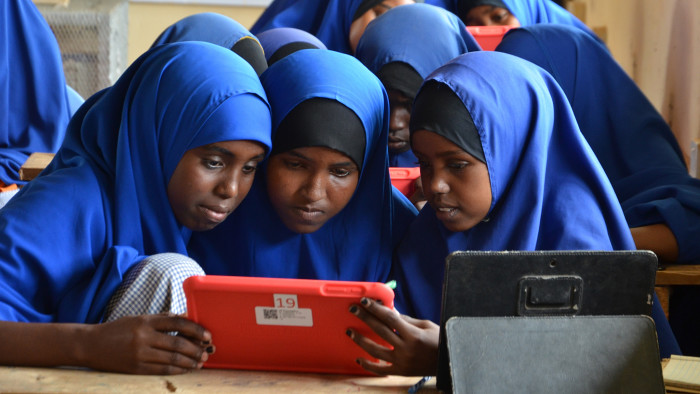Closing the education gap for refugee children

Simply sign up to the Education myFT Digest -- delivered directly to your inbox.
Kuach Tutkuay remembers the pain when he was forced as a child to flee without family or friends from conflict in South Sudan in 2000 — and the ambivalence of the authorities as he struggled to remain in education once he arrived in the Kakuma refugee camp in northern Kenya.
“There were too many of us, and only a few managed to get into a school,” he says. “We had no access to books, and many of those who failed to get the marks dropped out.” When fighting across the border eased, he only managed to avoid the pressure to return home when a sponsor agreed to pay his way through secondary school.
His plight is typical of the difficulties facing the growing number of refugees around the world. They are squeezed between different systems and cultures, while struggling to overcome personal trauma, ambivalence by the host country and inadequate support by the local system and international donors alike.
No issue in humanitarian crises is more neglected, with greater negative long-term consequences, than education for refugees, aid experts say. This has triggered growing debate and the creation of several alliances to mobilise funding and political support against a stark backdrop. Half of the world’s 25.4m refugees are children; only three-fifths of those of primary school age are in school compared to 92 per cent of children globally.
“The reality is we’ve got an architecture for dealing with refugees that is woefully misaligned with the scale of the problem that we are trying to address and where we have to address it,” says Kevin Watkins, head of Save the Children in the UK.
He says the risks of failing to do more include further emigration from poorer to richer regions; the waste of social and economic potential; and the radicalisation of young people.
A big concern for Mr Watkins and others is inadequate and inappropriate funding. Of the total humanitarian aid spent worldwide, just 2 per cent goes to schooling. “Education has never been seen as central to humanitarian provision,” Mr Watkins says. “No single agency has taken on full responsibility, so you have overlapping mandates and lots of small projects that fall enormously short of universal coverage.”
“In a crisis, people think about health, shelter, water and sanitation,” says Amy Parker from Relief International, which works with refugees on schooling around the world. But “a safe base for children to give them a real foundation for recovery is essential”, she says, arguing the case for cash payments to parents to help children stay in school.
Funding provided by aid agencies is often short-term and inconsistent, and can create tensions with local officials and people who live close to refugee camps. “Donor demands are often to the detriment of a holistic approach,” says Ita Sheehy, senior education adviser at the UNHCR.
“Each one wants photos of kids wearing backpacks with their logos. They encourage non-governmental organisations to set up separate programmes to show their own contribution. We see an awful lot of projects that last two to three years and then fizzle out.”
In the case of Syria, most refugees have fled to countries such as Lebanon and Jordan. Lebanon is classified as an upper middle-income country and so is ineligible for aid. Until last year Jordan was also in this classification.
This is one reason why Mr Watkins worked in Lebanon to develop a “double shift” system, in which local schools increase their capacity by pushing the day earlier and adding a second set of lessons in the afternoons to cope with a surge in demand from refugees. This points to the need for increased funding of national education systems so host countries can cope. There is also considerable potential for companies to offer digital tools for remote learning.
Refugees often want to return home and seek continued teaching in their own language and curriculum. Host countries can be hostile to integrating refugees, whom they may not want to grant rights equivalent to those of their citizens. States also often refuse to accept refugee teachers’ qualifications.
“Permanent structures imply that a refugee crisis will continue but it’s a reality,” says Pauline Rose, professor of international education at Cambridge university. Like others, she argues in favour of more support for national school systems to absorb migrants, help them switch to a different language and curriculum, and to relieve the traumas experienced by many refugee children.
Mr Tutkuay is a good example of successful assistance. After returning to South Sudan he had to flee again when the conflict restarted in 2013. Yet, with his Kenyan qualifications, he was able to obtain a university degree in Nairobi. He is now working for a development agency, and hopes he can use his experience to improve the prospects of other future refugee children.

Comments